|
|
|
| FTLComm - Tisdale - September 13, 1999 | |
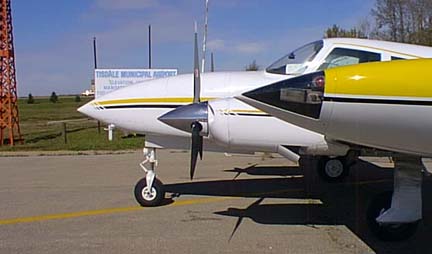 When we think of a twin engined light aircraft the airplane image that comes to mind is Cessna's 310, if you are old enough you would remember it as the star of an Australian television series in the mid fifties called "Sky King" which dealt with Australia's flying doctor service. The first 310s took to the sky in 1955, the so-called "tuna tank" models. The earliest version of the aircraft had a short nose and the tip tanks were the shape of a tuna fish. Cessna's original decision to store the main fuel supply in wing tips tanks was a safety |
|
feature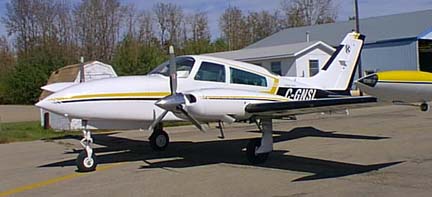 ,
a wheels up landing ,
a wheels up landingor hard landing would see the fuel tanks snap off and reduce the risk of frying the plane. This actually occurred with one of Cessna's test versions of the original aircraft. Over the years refinements were carried out increasing engine power, adding windows and finally in 75 the longer nose making room for more avionics and luggage space. |
|
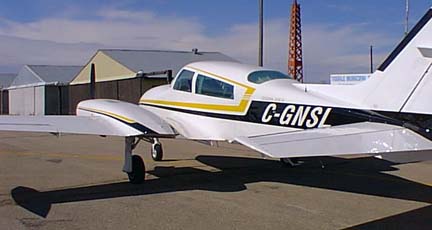 Though
equipped with six Though
equipped with sixseats and plenty of room for that many people the aircraft's fuel and passenger combination has to be carefully monitored. With full fuel and all the seats full this aircraft would be 1,440 pounds over its limit. When people talk about aircraft they normally assume that a twin engined aircraft has a second engine for redundancy and is therefore safer, since an engine failure would not bring it out the sky. In actual fact twin engine aircraft have two engines because they |
|
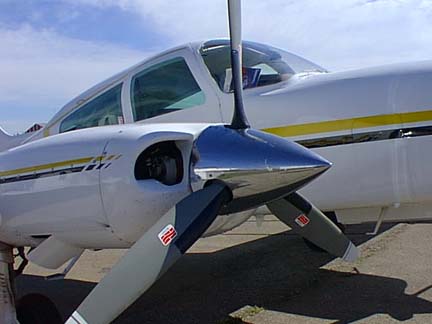 need two
engines. need two
engines.The Cessna 310 uses two 285 horse fuel injected engines that give it outstanding performance capable of cruising at 224 miles per hour and with a light load of passengers up to 1,400 nautical miles. With this excellent performance this aircraft has long been the choice of Airspray's bird dog pilots who shepherd A-26 through their water bombing runs. Here in Saskatchewan 310s have long been the standby for the cheque collection system and of course air taxi operators everywhere have found the sleek and business like appearance of this aircraft to provide short distance business charters. From a pilot's point of view |
|
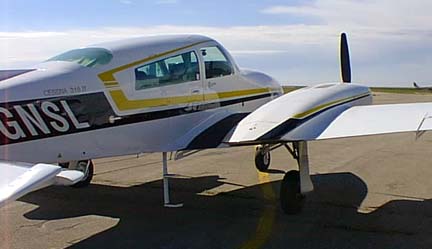 the 310 is
quite a challenge. the 310 is
quite a challenge.The aircraft is known for its rather delicate landing gear and with its fuel so far outboard taxiing is done slowly with no quick turns. The aircraft also is known for very rapidly morphing from a bird to a brick requiring precise landing techniques as a high flair result in a hard arrival which in turn could result in collapsing landing gear. Most accidents that occur with this aircraft involve these elements. The flaps and gear are electrical so that an engine out will not disable these systems as the alternator on the operating engine will put you |
|
 safely back
on the ground. safely back
on the ground.The real nightmare with the 310 is one of those things that pilots rarely talk about but just sort their way through is the aircraft's fuel system. In preflight there are no less then ten points to drain under that machine and in flight a pilot must stay on top of what he has where. Transfer from left to right is not an option, drain the mains first, using from tips with full mains can result in unused fuel being pumped overboard |
|
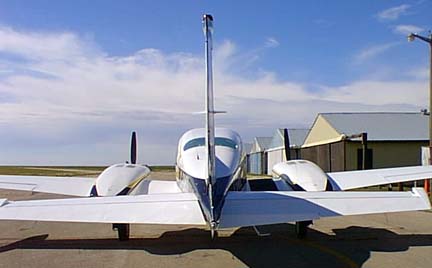 are just a few
of the little are just a few
of the little adventures that can accompany fuel management with the 310 or any vintage. The last one was made in 1981 but will be charging around the skies for decades to come. The large numbers made and their relative low price make them excellent value for money aircraft despite their high maintenance and insurance costs. In the mid 80s a Tuna Tank model could be purchased for about the same price as a 182 but later model versions like this one can still be purchased for less money then a combine. |
|
| Timothy W. Shire | |
| ---------------------Reference: | |
1981 Aircraft Directory, Editors of Plane and Pilot, ISBN 0-918312-00-0 |
|
Used Aircraft - Believed to be mid 80s article, a aircraft dealer sent me this seven page document in 1986 |
|
